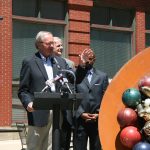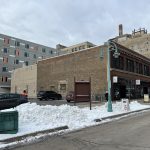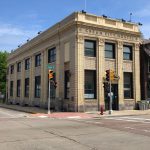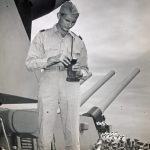A Short History of Milwaukee’s Old Streetcar System
The city once had a dense system with 20 routes that helped change the city. Why did it die and what is its legacy?
After repeated attempts to stall its passage, a new streetcar project was approved for Milwaukee and plans are underway to construct it. As the city embraces this form of transit, its worth looking back to the past and to the decades of experience Milwaukee had with an older form of the streetcar. Whatever happened to the original streetcars? How did they contribute to the life and economy of the city? Are there any lessons to be learned from the historic trolleys?
Milwaukee once boasted a dense streetcar network. At its zenith, with up to 20 routes, one could travel from as far north as Silver Spring Drive in Glendale to as far south as South Milwaukee, and as far west as West Allis or Wauwatosa. There were also interurban lines that took riders out to Waukesha or Watertown to the west; to East Troy, Burlington, southward to Kenosha, and northward to Sheboygan.
The system had humble beginnings. The present North Water Street Bridge to East Juneau Avenue saw the first horse-drawn cars on rails in the city on May 30, 1860. They were cutting-edge at the time but these horsecars suffered from serious disadvantages. The worst was the quality of service, often lacking in both comfort and speed. The horses also struggled pulling their passengers up hills.
The horses needed feed, required adequate rest, were subject to disease — and created a lot of poo. By one estimate, Milwaukee’s 12,500 horses in 1907 produced 133 tons of manure a day. The smell must have been something.
Inventors, including Thomas Edison, worked toward harnessing the power of electricity to replace the need for horses in urban transportation. German Ernst Werner von Siemens was the first to electrically power a train in Berlin in 1881. Later in 1884, native-Belgian Charles J. Van Depoele of Detroit produced the first safe method of powering streetcars by connecting the cars to overhead wiring via a “troller,” as it was first called.
The streetcars would go on to alter Milwaukee and the nation, changing how Americans built their cities, lived, entertained themselves, and conducted business. The streetcar allowed people to live further away from the bustle and pollution of the city. This led to the early growth of suburbs such as Wauwatosa and South Milwaukee.
Eventually the streetcar led to the segregation of how land was used, with a highly centralized Downtown, where most if not all business and entertainment was conducted, surrounded by residential neighborhoods.
This degree of centralization in Milwaukee, like other major American cities, pushed for taller buildings to allow for ever more people to work in the relatively small downtown area. Property in Downtown, as today, was more expensive. And land near the busiest streetcar intersections also had the highest land values.
Only the most lucrative firms could afford to conduct business. That’s why in Milwaukee downtown’s heyday, the department store giants such as Gimbels and Boston Store respectively stood at the busy intersections of West Wisconsin Avenue and Plankinton Avenue, and West Wisconsin Avenue and Fourth Street. Both locations were served by trolleys.
The streetcar became an integral part of life in Milwaukee and most other American cities. It peaked in the years between 1905 and 1915, before widespread use of cars.
So important were the streetcar lines to Milwaukeeans, that the community came together to support a strike against the corporate owners of The Milwaukee Electric Railway and Light Company. The strike began in 1896 when TMER&L’s workers called for higher wages and unionization. TMER&L declined to engage with its employees and brought in strikebreakers.
This was during the Gilded Age, and amidst the rampant corruption typical of the age, the public was in no mood to support wealthy businessmen who were buying their politicians. Milwaukeeans largely boycotted streetcar service. Local hotels would not provide room for the strikebreakers nor would grocers sell their produce. Even then-Mayor William Rauschenberger’s butcher refused him service over the issue. The strike lasted for two long months before some anarchists ended public support through an attack that would be labeled terrorism today. The assailants discharged rifles at two streetcars on successive days in June. Luckily, merely one passenger was injured.
Yet the streetcar would not last as the primary means of transportation in Milwaukee. Nationwide, ridership peaked around 1920 and steadily declined except during World War II. The reasons are many. They include the changing times, the fault of the streetcar companies themselves, and government policy and regulation.
Widespread adoption of gas-powered automobiles hurt ridership. The perception of slow and crowded trolley rides in outdated streetcars also pushed riders away. Many people also preferred buses because they were viewed as the cool new thing. Exacerbating this trend, many streetcars by the 1950s were older. Due to a lack of available capital, urban rail firms were hard-pressed for proper maintenance, let alone upgrading to the latest technology. The decline in riders hurt pushed these companies toward unprofitability.
Changing economics and poor long-term decisions on the part of the urban railways also hurt companies immensely. After World War I transit companies had to contend with a huge inflation of material costs, soaring employee wages, and inability to increase fares from five cents due to contractual obligations to the cities they served. It was also expensive to maintain the portions of the street occupied by the rails as well as the rails themselves.
By this time, due to Progressive Era politics, most states including Wisconsin had public service commissions whose duty was to regulate the street railways on behalf of the public. Before widespread use of autos, people were more limited in how they could get around: walk, horses, or the streetcar. So for the public, affordable use of the speedier streetcar was a vital interest. The flip side of the commissions’ protection of consumer interest was that in many cases regulation overzealously hurt the financial stability of the companies by not taking into account profitability. However, it should be noted that many street railway companies lost much sympathy because they were, as historian Stanley Mallach writes, often “guilty … of monopoly, financial manipulation, corruption, and gouging the public…”
Due to cost concerns, TMER&L established bus routes as early as 1920 to complement streetcar lines. The company believed it more cost-effective in many cases than installing additional rails. The first bus route went down Mitchell Street. No buses replaced streetcar lines until 1926 with the Lisbon Avenue route from Washington Park to Wanderer’s Rest Cemetery, now Lincoln Memorial Cemetery. Then, in 1931 buses took over the Oakland Avenue route from Silver Spring Drive to Fox Point.
But it was a labor strike and riot in 1934 which swayed TMER&L’s management to believe streetcars were no longer tenable. TMER&L then committed to complete abandonment of its streetcar lines. The company that is now WE Energies spun off its transit division as The Milwaukee Electric Railway & Transit Company. As TMER&T moved away from rail transit service, it still contended with city regulation which likely perpetuated streetcar use longer than the company would have intended.
By 1950 the city was at a crossroads in examining how to proceed on transportation policy. It could push for newer streetcars with the latest technology, switch to trolleybuses tethered to electrical lines, or move toward transit service by gasoline buses. In 1948, Municipal leaders had commissioned a firm, Coverdale & Colpitts Consulting Engineers, to analyze these options to find the best public option.
The study compared Milwaukee and similar Northern cities, it examined demographic changes, the pros and cons of different transportation modes, as well as public preference. The engineers ultimately encouraged the city to fully convert from street railways to trackless transit. This was based on data showing increased public automobile use and declines in non-rush-hour patronage. Data showed Milwaukee’s citizens preferred trackless trolleys (electric-powered buses tethered to power lines) to railed ones, and the firm argued that trackless trolleys were a better technology. Historic documents show city leaders leaned in that direction around the time of the engineering firm’s verdict.
Eventually all the streetcar lines became trackless and those later yielded entirely to the motor buses we know today. The last streetcar ran on March 2, 1958 with many people coming out to give it one last hurrah.
Article Continues - Pages: 1 2
More about the Milwaukee Streetcar
For more project details, including the project timeline, financing, route and possible extensions, see our extensive past coverage.
- Council Kills Streetcar’s ‘Festivals Line’ - Jeramey Jannene - Jul 31st, 2024
- Streetcar Will Use Festivals-Oriented Route Through Summer - Jeramey Jannene - Jul 9th, 2024
- The Hop’s Lines Will Merge For Easier Summerfest Service - Jeramey Jannene - May 30th, 2024
- Streetcar Begins Daily Service To The Couture, BRT Will Soon Follow - Jeramey Jannene - Apr 11th, 2024
- Milwaukee’s Three Streetcar Extensions Need Mayoral Direction - Jeramey Jannene - Nov 8th, 2023
- Transportation: Streetcar Extension Opens Sunday - Jeramey Jannene - Oct 28th, 2023
- Ride Along On Streetcar Extension Before It Opens - Jeramey Jannene - Oct 11th, 2023
- Lakefront Streetcar Extension Opens October 29 - Jeramey Jannene - Aug 22nd, 2023
- Streetcar Ridership Has Climbed For 27 Straight Months Year-Over-Year - Jeramey Jannene - Jul 28th, 2023
- Transportation: Harley-Davidson Is New Streetcar Sponsor - Jeramey Jannene - Jul 7th, 2023
Read more about Milwaukee Streetcar here






















Not mentioned here is the passage by congress in 1935 of the ‘Utilities Holding Company Act’ which forced generating companies to dispose of their transit lines. As of 1938, streetcars and interurbans were supposed to pay their own way; the result, barring the artificial stimulus caused by World War II, was disastrous. TMER&T (the free-standing transit company), did nothing to upgrade stock or service, and the result was andonment. Milwaukee mayor Frank Zeidler and others tried to establish a regional transit authority, but the state legislature of the time wouldn’t go along (which ought to sound familiar to Milwaukeeans of today.)
Where can one find a map showing all the former streetcar routes?
It was that last glass of Braumeister that fuddled my comment above; the word should be ‘abandonment.’
@Big Al: TMER&T used to issue system maps in the late 40’s and early 50’s. I’d start at the library’s map collection; also look for Bulletin 112 of the Central Electric Railfan’s Association, published in 1972. This is a dictionary-sized history of Milwaukee’s streetcar and interurban systems, full of maps and illustrations. Also, a couple of websites can provide various maps and links: http://www.tmer.org, and http://www.northshoreline.org. Ken Smith doesn’t mention it, but the North Shore system operated streetcar service on Wisconsin Avenue and along south Fifth and Sixth streets until 1951. On the North Shore site there’s an entertaining 1945-vintage film of a trip from Roosevelt Road in Chicago to the Milwaukee terminal at Sixth and Michigan.
The Milwaukee Transit Archives & Museum, the area’s archival museum for Milwaukee’s transit history, has a transit map collection, as well as a large framed map of city transit lines in 1915. There are also several smaller pamphlets containing streetcar routes as early as 1909. A copy of the CERA Bulletin 112 on the “TM” is also available for viewing and research. The museum, located at 2270 S. 102nd St. in West Allis, is open to the public most Mondays and Thursdays from 11 to 4, or by arranging a visit by phoning 414-345-7210. More information and photos are on the website at http://www.milwtransit.org.
The North Shore Line did operate local streetcar service in Milwaukee until 1951, with interurban service to Chicago lasting until 1963. City cars traveled from Oklahoma Av. along private right-of-way to Harrison St., then via 5th and 6th Sts. and the 6th St. viaduct to the Milwaukee depot at 6th & Michigan. Prior to 1920, city cars traveled along N. 5th St., then east on W. Wells St. and south on N. 2nd St.to a storefront depot near Wisconsin Av. An operating HO model layout of the NSL Milwaukee Depot and the entire city block that it sat upon is on permanent display at the Milwaukee Transit Archives & Museum.
The impact upon Milwaukee from the simultaneous National City Lines conspiracy, though never fully examined regarding TMER&L itself, cannot be diminished if only because of the national attitudes and prejudices fostered by the NCL executives and corporations against rail transit despite their later federal convictions on charges of conspiracy.
http://www.chicagorailfan.com/mkehist.html
I was interested in hard historical info-old maps of the lines and the like-instead of preachy, politic-based tripe. Waste of time.